
Columbia was the only Latin American country to send combat troops into Korea during the war. It was also the first time that Colombian forces had engaged in a foreign military operation in 127 years.
Colombia was a signatory to the Declaration of the United Nations in 1943, and one of the original 51 signatory countries at the San Francisco Conference held on Apr. 25-26, 1945.1 Colombian President Laureano Eleuterio Gómez Castro (1889 – 1965) was well aware of the United Nations concept of collective security and how it might potentially benefit Colombia in the future. With the outbreak of the Korean War, he pushed the military to form an expeditionary force that could be deployed on behalf of the United Nations, which in turn would bolster U.S. – Colombian relations. On Sept. 6, 1950, the Colombian government offered a naval unit to the allied forces, but two weeks later added an infantry battalion, which did not yet exist. Colombian Decree #3927 (Dec. 1950) created Infantry Battalion No. 1 which was to assist the United Nations efforts in Korea. Interestingly enough, formal diplomatic relations between the Colombia and South Korea were not established until March 10, 1962. Since then, Colombian Veterans have received significant help from the Korean government in the form of scholarships and financial aid for their grandchildren.
The Colombian Army
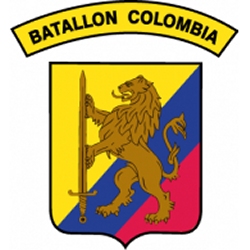
This design is found on Colombian shoulder patches used during the Korean War.
Excluding peacekeeping missions, Korea is Colombia’s only foreign military engagement. Colombia’s 1st Battalion was the first army unit to serve during the Korean Conflict. It arrived in Pusan, Korea on June 16, 1951, and was initially assigned to the US 24th Infantry Division, 21st Infantry Regiment. It subsequently was re-assigned to the US 7th Infantry Division, 31st Infantry Regiment. Colombia rotated 3 more battalions through Korea, all serving as part of the US 7th Infantry Division. Each of the 4 battalions had an approx. peak strength of 1,070 men. During the war, Colombian’s 3rd Battalion suffered the heaviest losses of the war. It was severely mauled during the fifth battle (March 23-26, 1953) on Old Baldy (Hill 268) when it was overrun by the numerically superior Chinese forces. In just ten days, the Batallón Colombia had suffered 313 casualties, the equivalent of two rifle companies. If not for the resistance of the Colombian troops at Old Baldy, the Chinese forces could have broken the 7th Division’s Main Line of Resistance and would have had a direct access route to Seoul.2 The Battalion suffered 95 killed-in-action, 30 missing-in-action and 97 wounded. The Chinese forces lost an estimated 750 troops. Old Baldy earned its nickname after artillery and mortar fire destroyed the vegetation on its crest. But as the highest point on a prominent east-west ridge, Old Baldy held strategic importance because it dominated terrain in three directions.
A total of 4,314 Colombian soldiers served in Korea. During the war, Colombia had a total of 163 killed, 448 wounded, 47 missing in action, and 28 prisoners of war. All the POWs were repatriated, with 6 during Operation Little Switch (April 20-26, 1953), and the remaining 22 during Operation Big Switch (August 5 to September 6, 1953). Colombian servicemen were awarded several foreign awards: 1 ROK Order of Military Merit, Ulchi Class, a ROK Presidential Unit Citation, 2 U.S. Legion of Merit medals; 18 U.S. Silver Stars; 25 U.S. Bronze Stars with V (valor) device and 9 U.S. Bronze Stars (without device) as well as 2 U.S. Presidential Unit Citations. One of the U.S. Presidential Unit Citations was for the Kumsong Offensive. The Batallón Colombia left Korea on Oct. 29, 1954, carrying home the remains of 141 soldiers. The veterans received a heroes’ welcome when they arrived at Buenaventura, Colombia on Nov. 25, 1954. Five days later, in Bogotá, the Batallón Colombia paraded proudly before thousands of people. In addition to the U.S. and Republic of Korea Presidential Unit Citations, all members received the UN Service Medal for Korea, the Republic of Korea’s War Service Medal. All the Colombian Army veterans were awarded the Colombian Valor Star for Korea. The Korean War was key to the development of a professional Colombian armed force. It also marked a new phase in the social and political transformation of the country. Having forged their leadership skills in combat, the officers of the Batallón Colombia led the country through some of its most trying times in the postwar period. Today, the legacy lives on as the Batallón Colombia serves as part of the Multinational Force and Observers in the Sinai.

The Colombian Armada
The Colombian Navy utilized three former US ships during the Korean War, with approx. 786 sailors servicing during the conflict. The ships utilized were: the ARC Almirante Padilla FG-11 (formerly the USCGC Groton PF-29) which served in Korea from May 8, 1951 to Jan. 19, 1952, the ARC CapitánTono (formerly USCGC Bisbee PF-46) which served from Nov. 23, 1950 to Oct. 20, 1951, and the ARC Almirante Brión F-14 (formerly USS Burlington PF-51) which served from July 18, 1953 to Oct. 11, 1955.3 For more information on the Colombian navy in Korea, see “Across the Pacific to War: The Colombian Navy in Korea, 1951–1955”.
Korean Campaign Medal
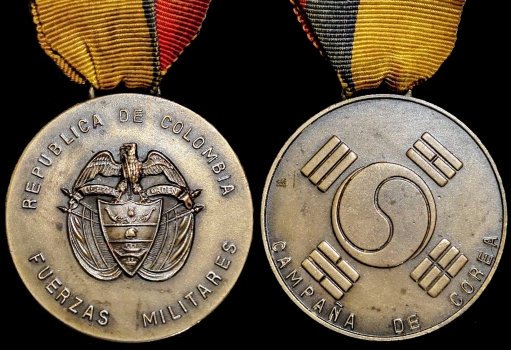
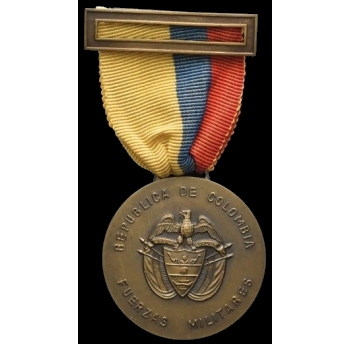
I have seen this medal referred to as “Medalla de la Campaña de Corea”, but I am unsure if that is the correct title. The obverse of this extremely rare bronze medal features the Seal of the Colombian Republic and the inscriptions, Republica de Colombia ‘Republic of Colombia’ and Fuerzas Militares ‘Military Forces’. The reverse features the Korean Taeguk with the inscription, Campaña de Corea ‘Korea Campaign’ below.
Medal for Service in International War (Overseas Wars) “Medalla por Servicios en Guerra Internacional”
The medal for services in “International War” was created by Decree No. 812 in 1952. The awards are intended for members of the Military Forces, regardless of rank, who serve in foreign conflicts. The award has two categories, namely: an Iron Cross (Cruz de Hierro) and a Bronze Star (Estrella de Bronce). The planchet designs for each decoration were modelled on foreign decorations, namely: the German ‘Iron Cross’ and the U.S. ‘Bronze Star’. Both medals have identical ribbons with a Korean flag design centered on a white center stripe and narrow yellow-blue-red stripes on each side, which represent the Colombian National Flag. Both ribbons are fitted at the top with a passador suspension, a distinctive hollow buckle. Some later reproduction top bars have been observed with the inscription ‘Colombia’ or ‘Corea’. The Medal for Service in International War has only been authorized for issue during the Korean War (With a quick ribbon change, they could possibly be awarded for other conflicts, but to date have not.) For both types of award, a laurel device on the ribbon indicates distinguished valor, while additional awards are indicated by a bronze oak leaf.
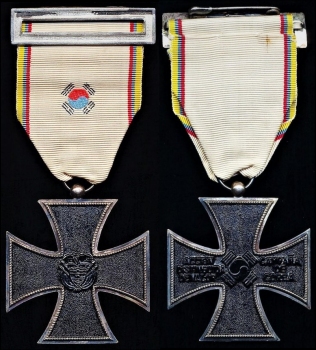
The Heroes Cross, ‘Cruz di Hierro’, commonly referred to as the Colombian Iron Cross
The Iron Cross was Colombia’s highest gallantry decoration for the Korean War. It could also be awarded for distinguished leadership in combat. It can be awarded with a laurel device (palm) for distinguished valor; or without for merit or devotion to duty in action.
The planchet obverse has the raised Colombian Coat of Arms. The reverse has a raised emblem of the South Korean flag, (a ‘Taeguk’ surrounded by 4 trigrams, same as the ribbon). On the left and right arms of the cross are the respective legends ‘Accion Distinguida De Valor’ & ‘Campaña de Corea’. The planchet is approx 44 mm, and mounted with a double ring suspension.
The Bronze Star, ‘Estrella de Bronce’
The medal is a faceted five-pointed star in bronze. On the obverse, in the center, is the Coat of arms of Colombia surrounded by a wreath. On the reverse in the center is the national flag of the Republic of Korea, under the inscription ‘Campaña de Corea‘. The medals hang from a ribbon with an integrated lug suspension, not too dissimilar than a fob suspension slot.

The Medal of Honor for Mission Accomplished “HONOR / AL DEBER COMPLIDO”
This is an Infantry Battalion Medal which was established on Oct. 21, 1965 and issued to Colombian military personnel. The obverse has soldiers holding the Colombian flag atop a mountain, with a half-wreath of laurel leaves at the base of the medal. The flag is done in yellow, blue and red enamels. There is no hallmark. On the reverse, there is a shield with a rampant lion. This is the sleeve insignia of the battalion. In an arch across the top is the inscription “BATTALION DE INFANTERIA COLOMBIA”. At the bottom is the inscription, in two lines, “HONOR / AL DEBER COMPLIDO” (Honor / Mission Accomplished). The planchet is 31.5 mm (w) x 32.5 mm (h) and is suspended by a pinback hanger. These can be found in Bronze, Silvered Bronze, and according to some sources, pure silver. There was a dealer in Arizona, who purchased the original dies from Colombia, and produced these medals for many years. All the medals that I have seen with an original ribbon only have bronze pendants. However, Kevin Ingraham in his book, “Honors, Medals and Awards of the Korean War 1950-1953” states that the Colombian Infantry Battalion medal was struck on the order of LTC Ruiz-Novoa. A small number, probably no more than fifty, were struck in Japan in silver and that they may have been produced for the officers. He also states that the more common bronze issues may have been produced for the enlisted men. I found another information source that states that a rare variety of this medal was produced in Japan, which has several design variances, including the absence of the wreath at the base of the obverse. Personally, I believe that more research is needed.
This is commonly referred to as the “Old Baldy Medal”. Unfortunately, it is sometimes called the “Mount Baldy Medal”. The battle that the 3rd battalion fought in was at Old Baldy (Hill 266) in Korea and not at Mount Baldy, which is located in Southern California.

The picture source is: eMedals
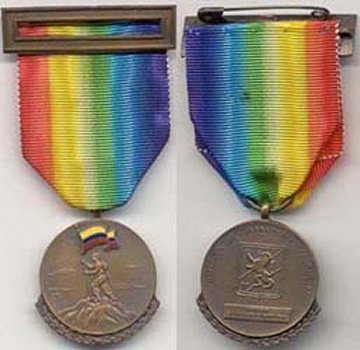
Appears to be brass with an original ribbon.
The picture source is: The Medal Hound

The picture is from the George Notarpole Collection.
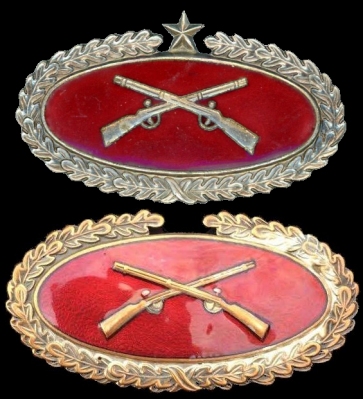
Combat Infantry Badge for International Conflict
This Combat Infantry Badge (CIB) is very similar in appearance to the wound badge. The center depicts two antique crossed muskets from the period of Colombia’s long struggle for independence from Spain. An independence that was finally achieved on July 20, 1819. The badge is surrounded by an elliptic oak-leaf wreath. Some badges have a reverse inscription “Battalon Infanteria” / “Corea”, in two lines. The Officer’s version has a star on the top, center of the wreath. These were also awarded to Americans who fought alongside the Colombians. American soldiers, who were awarded the badge, wear it on the right side of the chest as opposed to Colombian personnel, who wear it on the left.
Combat Wound Badge “Insignia de herida de Colombia”
The Colombian wound badges are approx 45 to 46 mm long x 15 to 16 mm wide. The badges have an outer gilt wreath/frame/border in the shape of an elongated oval. There are two types of background enamel, red and blue. A 3/16” bronze star is added for each of the first two wounds to the red enamel badge. Purportedly, a Combat Wound Badge with blue enamel is for the 3rd wound. However, Wikipedia’s web page on Colombian Military Decorations, which primarily covers the countries currently issued decorations, has an interesting comment under the heading “Medal for Those Wounded in Action (Medalla Militar “Herido en Acción”)”.4 It states (sic), “Note: the service badge consists of a horizontal blue enameled oval, bordered by a gold wreath, with small 5-point stars in the center according to number of awards”. I have not been able to find a two star, blue enamel badge indicating a 4th wound, and I have not been able to find any additional information that would clarify the situation.
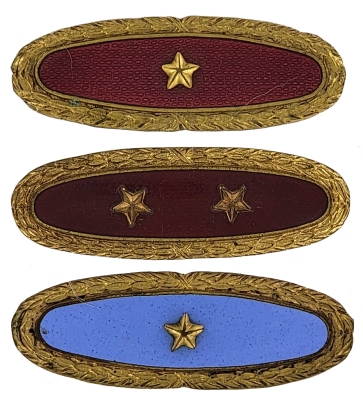
Colombia has a war Museum located at Calle 10 # 4–92, Bogotá D.C., Colombia. Their website is located at www.museomilitarco.com/en/. Their email address is Museomilitar@cgfm.mil.co. They can also be contacted by phone.
Korea maintains a memorial to the Colombian Military who fought in the Korean War. It is located at 213-7 Yeonhi-dong, Seo-gu, Incheon, South Korea.
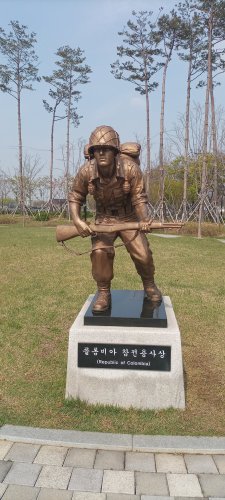
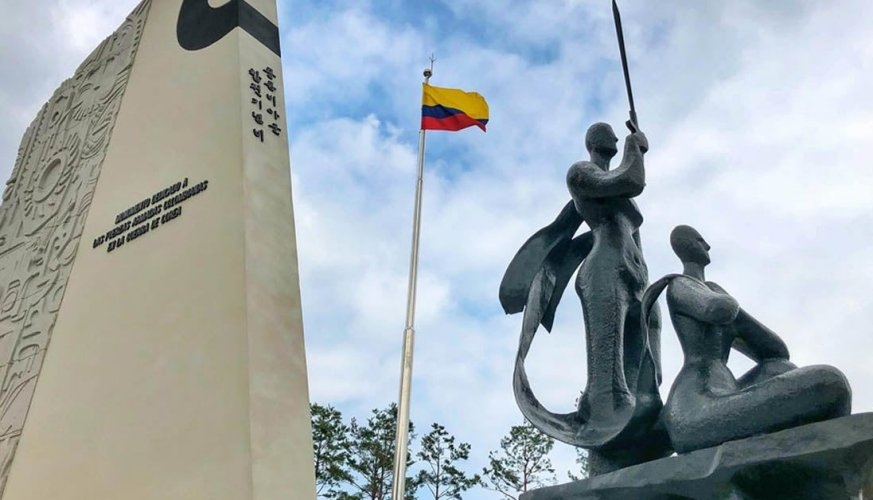
Footnotes:
- The Conference agreed upon the Charter of the United Nations and the Statute of the new International Court of Justice. The Charter had to be approved by the respective governments of the delegates. The Charter would not come into force until the governments of China, France, Great Britain, the Soviet Union and the United States and a majority of the other signatory states had ratified it through their respective governments. On Oct. 24, 1945 (now observed annually as United Nations Day) this condition was fulfilled, and the United Nations came into existence.
- The Battle of Old Baldy actually refers to a series of engagements, which were spaced over a ten-month period.
- “ARC” stands for “Armada de la República de Colombia”.
- The military medal “Wounded in action” was created in article 42 of Decree 1816 of 2007, to recognize officers, non-commissioned officers, soldiers, marines and civilians of the Military Forces who provide their services in areas where operations are carried out, for the restoration and maintenance of public order, and are wounded in combat or as a consequence of enemy action.
